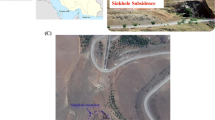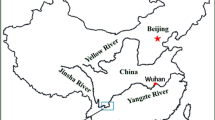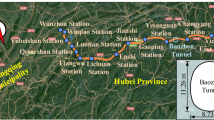Abstract
The Wudongde Hydropower Station is constructed in layered strata that typically have steep dip angles. These features, together with the folds and faults that have developed in the strata, directly threaten the stability of the underground powerhouse. In this work, the behavior of the surrounding rocks under the original support measures is detailed in terms of rock mass deformation, anchor bolt stress, and extent of the excavation-disturbed zone, as obtained from safety monitoring and field testing. The characteristics of deformation and cracking of the surrounding rocks were also interpreted. To enhance rock mass stability, the support design and construction process were optimized and the positions liable to cracking treated. The efficiency of suggested scheme is verified by subsequent safety monitoring data and field testing. Then, a transversely-isotropic elastoplastic constitutive model for the layered rock masses was established. Numerical simulations are performed during the construction process to provide reference for decision making. The calculated deformations are in good agreement with the monitored values and they tended to be more stable. The plastic zones of the surrounding rocks fall within the range controllable using cables. Thus, the proposed measures are necessary and ensure sufficient stability. Finally, the mechanisms for the deformation and cracking of the surrounding rocks during the construction process are discussed. The work described aims to deepen our understanding of the mechanical properties of layered rock masses with steep dip angles and to improve the design philosophy.























Similar content being viewed by others
References
Adhikary DP, Dyskin AV (1997) Modelling the deformation of underground excavations in layered rock masses. Int J Rock Mech Min Sci 34(3):5
Bakun-Mazor D, Hatzor YH, Dershowitz WS (2009) Modeling mechanical layering effects on stability of underground openings in jointed sedimentary rocks. Int J Rock Mech Min Sci 46:262–271
Cai M (2008) Influence of second principal stress on rock fracturing and strength near excavation boundaries-insight from numerical modeling. Int J Rock Mech Min Sci 45:763–772
Cai M, Kaiser PK, Martin CD (2001) Quantification of rock mass damage in underground excavations from microseismic event monitoring. Int J Rock Mech Min Sci 38:1135–1145
Cui Z, Liu D, Wu F (2014) Influence of dip directions on the main deformation region of layered rock around tunnels. Bull Eng Geol Environ 73(2):441–450
Ding XL, Sheng Q, Wu AQ, et al (2002) Numerical modeling on the excavation and reinforcement for the underground powerhouse in the Shuibuya project. Chin J Rock Mech Eng 21(Supp.): 2162–2167 (in Chinese)
Ding XL, Dong ZH, Lu B et al (2008) Deformation characteristics and feedback analysis of surrounding rock of large underground powerhouses excavated in steeply dipped sedimentary rock strata. Chin J Rock Mech Eng 27(10):2019–2026 (in Chinese)
Dong XS, Tian Y, Wu AQ (2004) Rock mechanics in hydraulic engineering. China Water Power Press, Beijing (in Chinese)
Goodman RE (1976) Methods of Geological Engineering in Discontinuous Rocks, St Paul New York: West Publishing Group
Han XY, Ai K, Zhou CH (2012) Geostress regression analysis on Wudongde hydropower station in Jinsha River [R]. Wuhan, Yangtze River Scientific Research Institute (in Chinese)
He MC (2011) Physical modeling of an underground roadway excavation in geologically 45° inclined rock using infrared thermography. Eng Geol 121:165–176
Huang SL, Xu JS, Ding XL et al (2010) Study on layered rockmass composite model based on characteristics of structural plane and its application. Chin J Rock Mech Eng 29(4):743–756 (in Chinese)
Jia P, Tang CA (2008) Numerical study on failure mechanism of tunnel in jointed rock mass. Tunn Undergr Space Technol 23:500–507
Lee YK, Pietruszczak S (2008) Application of critical plane approach to the prediction of strength anisotropy in transversely isotropic rock masses. Int J Rock Mech Min Sci 45(4):513–523
Lekhnitskii SG (1981) Theory of elasticity of an anisotropic body. Mir Publishers, Moscow
Li ZK, Zhou Z, Tang XF et al (2009) Stability analysis and considerations of underground powerhouse caverns group of Jinping I hydropower station. Chin J Rock Mech Eng 28(11):2167–2175 (in Chinese)
Mojtaba A, Mohammad HB (2015) Modified criteria for sliding and non-sliding failure of anisotropic jointed rocks. Int J Rock Mech Min 73(1):95–101
Mróz Z, Maciejewski J (2002) Failure criteria of anisotropically damaged materials based on the critical plane concept. Int J Numer Anal Met 26(4):407–431
Nasseri M, Rao KS, Ramamurthy T (2003) Anisotropic strength and deformational behavior of Himalayan schists. Int J Rock Mech Min Sci 40(1):3–23
Ni SH, Xiao M (2009) Failure characteristics and computational method of layered rock. J Hydraul Eng 40(7):798–804 (in Chinese)
Niandou H, Shao JF, Henry JP et al (1997) Laboratory investigation of the mechanical behaviour of Tournemire shale. Int J Rock Mech Min Sci 34(1):3–16
Pei QT, Dong ZH, Zhang L (2017) Scientific report on the fast measurement and back analysis for the underground powerhouse group caverns construction of Wudongde hydropower project located on Jinsha River [R]. Wuhan: ChangJiang River Scientific Research Institute (in Chinese)
Ramamurthy T, Arora VK (1994) Strength predictions for jointed rocks in confined and unconfined states. Int J Rock Mech Min Sci Geomech Abs 31(1):9–22
Sitharam TG, Sridevi J, Shimizu N (2001) Practical equivalent continuum characterization of jointed rock masses. Int J Rock Mech Min Sci 38(3):437–448
Song S, Feng X, Liao C et al (2016) Measures for controlling large deformations of underground caverns under high in-situ stress condition–a case study of Jinping I hydropower station. J Rock Mech Geotech Eng 8(5):605–618
The National Standards Compilation Group of the People’s Republic of China (2015) Standard for engineering classification and rock masses (GB/T50218–2014). China Planning Press, Beijing (in Chinese)
Tien YM, Kuo MC (2001) A failure criterion for transversely isotropic rocks. Int J Rock Mech Min Sci 38(3):399–412
Tien YM, Kuo MC, Juang CH (2006) An experimental investigation of the failure mechanism of simulated transversely isotropic rocks. Int J Rock Mech Min Sci 43(8):1163–1181
Triantafyllidis T, Gerolymatou E (2014) Estimation of the strength of stratified rock mass. Rock Mech Rock Eng 47(2):535–547
Wu JH, Ohnishi Y, Nishiyama S (2004) Simulation of the mechanical behavior of inclined jointed rock masses during tunnel construction using discontinuous deformation analysis (DDA). Int J Rock Mech Min Sci 41(5):731–743
Wu F, Hu X, Gong M et al (2010) Unloading deformation during layered excavation for the underground powerhouse of Jinping I Hydropower Station, Southwest China. Bull Eng Geol Environ 69(3):343–351
Xiao YX, Feng XT, Feng GL et al (2015) Mechanism of evolution of stress–structure controlled collapse of surrounding rock mass in caverns: a case study from the Baihetan hydropower station in China. Tunn Undergr Space Technol 51:56–67
Xu DP, Feng XT, Chen DF et al (2017) Constitutive representation and damage degree index for the layered rock mass excavation response in underground openings. Tunn Undergr Space Technol 64:133–145
Yeung MR, Leong LL (1997) Effects of joint attributes on tunnel stability. Int J Rock Mech Min Sci 34(3):348
Zhang XM, Feng Y, Yang JS (2010) Experimental study on anisotropic strength properties of sandstone. Electron J Geotech Eng 15:1325–1335
Zhang Y, Xiao PX, Ding XL et al (2012) Study of deformation and failure characteristics for surrounding rocks of underground powerhouse caverns under high geo-stress condition and countermeasures. Chin J Rock Mech Eng 31(02):228–244 (in Chinese)
Zhou Z, Gong MF, Tang XF et al (2009) Report on mechanism of the surrounding rock mass deformation failure and support design for the underground powerhouse group caverns construction of Jinping I hydropower project located on Yalongjiang River [R]. Chengdu Hydroelectric Investigation and Design Institute of SPC, Chengdu (in Chinese)
Zhou YY, Feng XT, Xu DP et al (2017) An enhanced equivalent continuum model for layered rock mass incorporating bedding structure and stress dependence. Int J Rock Mech Min Sci 97:75–98
Acknowledgements
The authors gratefully acknowledge the National key research and development project of China (No. 2016YFC0402008), the financial support of the National Science Foundation of China (Nos. 51539002, 51609018, 51779018, 51809014) and the Basic Research Fund for Central Research Institutes of Public Causes (No. CKSF2017030/YT, CKSF2017054/YT). The work in this paper was also supported by funding from the National key research and development project of China (Nos. 2016YFC0401802, 2016YFC0401804).
Author information
Authors and Affiliations
Corresponding author
Rights and permissions
About this article
Cite this article
Ding, X., Niu, X., Pei, Q. et al. Stability of large underground caverns excavated in layered rock masses with steep dip angles: a case study. Bull Eng Geol Environ 78, 5101–5133 (2019). https://doi.org/10.1007/s10064-018-01440-8
Received:
Accepted:
Published:
Issue Date:
DOI: https://doi.org/10.1007/s10064-018-01440-8




